Narasimha
Narasimha (Sanskrit: नरसिंह IAST: Narasiṃha, lit. man-lion) is a fierce avatar of the Hindu god Vishnu, one who incarnates in the form of part lion and part man to destroy evil and end religious persecution and calamity on Earth, thereby restoring Dharma.[1][2]
| Narasimha | |
|---|---|
God of Protection | |
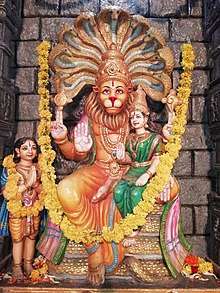 Narasimha-fourth avatar of Vishnu | |
| Affiliation | Lion headed man, fourth Avatar of Vishnu[1] |
| Weapon | Chakra, mace, Nails and Jaws |
| Festivals | Narasimha Jayanti, Holi |
Narasimha iconography shows him with a human torso and lower body, with a lion face and claws, typically with a demon Hiranyakashipu in his lap whom he is in the process of killing. The demon is powerful brother of evil Hiranyaksha who had been previously killed by Vishnu, who hated Vishnu for killing his brother.[3] Hiranyakashipu gains special powers by which he could not be killed during the day or night, inside or outside, by any weapon, and by man or animal.[4] Endowed with new powers, Hiranyakashipu creates chaos, persecutes all devotees of Vishnu including his own son.[1][4][5] Vishnu understands the demon's power, then creatively adapts into a mixed avatar that is neither man nor animal and kills the demon at the junction of day and night, inside and outside.[1] Narasimha is known primarily as the 'Great Protector' who specifically defends and protects his devotees from evil.[6] The most popular Narasimha mythology is the legend that protects his devotee Prahlada, and creatively destroys Prahlada's demonic father and tyrant Hiranyakashipu.[4][7]
Narasimha legends are revered in Vaikhanasas, Sri Vaishnavism, Madhwa Brahmins but he is a popular deity beyond these Vaishnava traditions such as in Shaivism.[8] He is celebrated in many regional Hindu temples, texts, performance arts and festivals such as Holika prior to the Hindu spring festival of colors called Holi.[4][9] The oldest known artwork of Narasimha has been found at several sites across Uttar Pradesh and Andhra Pradesh, such as at the Mathura archaeological site. These have been variously dated between 2nd and 4th-century CE.[10]
Etymology
The word Narasimha consists of two words "nara" which means man, and "simha" which means lion. Together the term means "man-lion", referring to a mixed creature avatar of Vishnu.[1][4]
He is known as Narasingh, Narasingha,Nrusingha, Narasimba and Narasinghar in derivative languages. His other names are Agnilochana (अग्निलोचन) - the one who has fiery eyes, Bhairavadambara (भैरवडम्बर) - the one who causes terror by roaring, Karala (कराल) - the one who has a wide mouth and projecting teeth, Hiranyakashipudvamsa (हिरण्यकशिपुध्वंस) - the one who killed Hiranyakashipu, Nakhastra (नखास्त्र) - the one for whom nails are his weapons, Sinhavadana (सिंहवदन) - the whose face is of lion and Mrigendra (मृगेन्द्र) - king of animals or lion.[12]
Texts
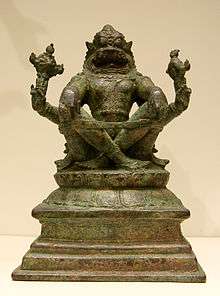
Vedas
The Vishnu hymn 1.154 of the Rigveda (1700-1200 BCE) contains a verse with allusions to a "wild beast, dread, prowling, mountain-roaming",[13] which has been interpreted by some to be the Narasiṃha legend. Another hymn 8.14 alludes to the Namuci legend with "waters' foam you tore off, Indra, the head of Namuci, subduing all contending hosts", but the hymns does not present details.[14]
A more complete version of the Namuci legend is found in Shatapatha Brahmana of the Yajurveda in chapter 12.7.3.[14] Other references to Narasimha are found in the Vedic texts Vajaseneyi Samhita 10.34, Pancavimsa Brahmana 12.6.8 and Taittiriya Brahmana 1.7.1.6.[14]
The Indra-Namuci legend
Narasimha likely has roots in the metaphors filled Indra-Namuci legend in the Vedas.[14][15] Indra is the dharmic leader of the Devas who commands lightning, thunder, rain and rivers, while Namuci is a deceptive demigod Asura in competition for power. Namuci suggests peace to Indra, which the latter accepts. He demands Indra to promise that he will neither try to slay him with his "palm of the hand nor with the fist", neither in day nor in night, neither "anything that the dry" nor "anything that is moist". Indra agrees.[14][16]
After the deal is done, Namuci carries away all that nourishes the Devas: the Soma drink, the essence of food and the strength of Indra. The leader of the gods finds himself conflicted, feels bound by his promise. Indra then meets Saraswati (goddess of knowledge) and Ashvins.[14] They reply they will deal with Namuci, get it all back, if Indra agrees to share his powers, the essence of food and the Soma drink with them. Indra agrees. The gods and the goddess then come up with a creative plan. They pour out "foam of water" as a thunderbolt, which is neither dry nor moist, and the evil Asura Namuci is attacked and killed when it is neither day nor night.[14]
After Namuci is killed, the gods get all the powers back, but discover that Namuci had drunk the Soma already. The good was thus now mixed with his badness of his blood, which they did not want to drink. So, they extract the good out from the bad. Thus, good returns to the Devas, the bad is discarded.[14]
According to Deborah Soifer, the Vedic legend has many parallels with the Narasimha legend, it has the same plot, the same "neither-nor" constraints, and the same creative spirit that allows the good to vanquish the evil. Further, the Sanskrit words and phrasing such as "neither palm nor fist" and "neither day nor night" in the later Hindu texts is the same as in the Vedic texts. This suggests a link and continuity between the Vedic Namuci legend and the later Narasimha legend in the Puranas.[14] According to Walter Ruben, both versions along with several other legends in ancient and medieval texts reflect the Indian tradition against despots and tyrants who abuse power.[17]
Puranas
There are references to Narasiṃha in a variety of Purāṇas, with 17 different versions of the main narrative.[18] The Valmiki Ramayana (7.24), Harivaṃśa (41 & 3.41-47), Viṣṇu Purāṇa (1.16-20), Bhagavata Purāṇa (Canto 7),[19] Agni Purāṇa (4.2-3), Brahmāṇḍa Purāṇa(2.5.3-29), Vayu Purāṇa (67.61-66), Brahma-Purāṇa (213.44-79), Viṣṇudharmottara Purāṇa(1.54), Kūrma Purāṇa (1.15.18-72), Matsya Purāṇa(161-163), Padma Purāṇa(Uttara-khaṇḍa 5.42), Śiva Purāṇa (2.5.43 & 3.10-12), Linga Purana (1.95-96) and Skanda Purāṇa 7 (2.18.60-130) all contain depictions of the Narasiṃha Avatāra.[20][21]
History
Prahlāda legend
The Bhagavata Purāṇa describes that Vishnu, in his previous avatar as Varāha, killed the evil asura Hiraṇayakṣa. The younger brother of Hirṇayakṣa, demon king Hiraṇyakaśipu, hated Vishnu and wanted revenge.[3] He undertook many years of austere penance to gain special powers. Thereafter, Brahma offered Hiraṇyakaśipu a boon. Hiraṇyakaśipu asked, "Grant me that I not die within any residence or outside any residence, during the daytime or at night, nor on the ground or in the sky. Grant me that my death not be brought about by any weapon, nor by any human being or animal. Grant me that I not meet death from any entity, living or nonliving created by you. Grant me, further, that I not be killed by any demigod or demon or by any great snake from the lower planets." Brahma granted him the boon, and Hiraṇyakaśipu gained these powers.[4]
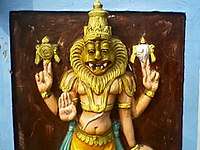
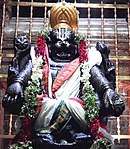
Hiraṇyakaśipu, once powerful and invincible with the new boon, began to persecute those who were devotees of Vishnu. Hiraṇyakaśipu had a son, Prahlāda, who disagreed and rebelled against his father. Prahlāda became a devotee of Vishnu. This angered Hiraṇyakaśipu, who tried to kill the boy—but with each attempt, Prahlāda was protected by Viṣṇu's mystical power. When asked, Prahlāda refused to acknowledge his father as the supreme lord of the universe and claimed that Viṣṇu is all-pervading and omnipresent.
_LACMA_M.82.42.8_(1_of_5).jpg)
Hiraṇyakaśipu pointed to a nearby pillar and asked if 'his Viṣṇu' is in it and said to his son Prahlāda, "O most unfortunate Prahlāda, you have always described a supreme being other than me, a supreme being who is above everything, who is the controller of everyone, and who is all-pervading. But where is He? If He is everywhere, then why is He not present before me in this pillar?" Prahlāda then answered, "He was, He is and He will be."[24]
In an alternate version of the story, Prahlāda answered,
He is in pillars, and he is in the smallest twig.
Hiraṇyakaśipu, unable to control his anger, smashed the pillar with his mace, and following a tumultuous sound, Viṣṇu in the form of Narasiṃha appeared from it and moved to attack Hiraṇyakaśipu in defense of Prahlāda. In order to kill Hiraṇyakaśipu and not upset the boon given by Brahma, the form of Narasiṃha was chosen. Hiraṇyakaśipu could not be killed by human, deva or animal. Narasiṃha was none of these, as he is a form of Viṣṇu incarnate as a part-human, part-animal. He came upon Hiraṇyakaśipu at twilight (when it is neither day nor night) on the threshold of a courtyard (neither indoors nor out), and put the demon on his thighs (neither earth nor space). Using his sharp fingernails (neither animate nor inanimate) as weapons, he disemboweled and killed the demon king.[24]
The Kūrma Purāṇa describes the preceding battle between the Puruṣa and demonic forces in which he escapes a powerful weapon called Paśupāta. According to Soifer, it describes how Prahlāda's brothers headed by Anuhrāda and thousands of other demons "were led to the valley of death (yamalayam) by the lion produced from the body of man-lion".[25] The same episode occurs in the Matsya Purāṇa 179, several chapters after its version of the Narasiṃha advent.[9]
Iconography
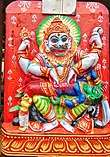
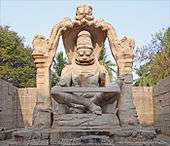
Narasimha is always shown with a lion face with clawed fingers fused with a human body. Sometimes he is coming out of a pillar signifying that he is everywhere, in everything, in everyone. Some temples such as at Ahobilam, Andhra Pradesh, the iconography is more extensive, and includes nine other icons of Narasimha:[4]
- Prahladavarada: blessing Prahlada
- Yogānanda-narasiṃha: serene, peaceful Narasimha teaching yoga
- Guha-narasiṃha: concealed Narasimha
- Krodha-narasiṃha: angry Narasimha
- Vira-narasimha: warrior Narasimha
- Malola-narasiṃha or Lakshmi-narasimha: with Lakshmi his wife
- Jvala-narasiṃha: Narasimha emitting flames of wrath
- Sarvatomukha-narasimha: many faced Narasimha
- Bhishana-narasimha: ferocious Narasimha
- Bhadra-narasimha: another fierce aspect of Narasimha
- Mrityormrityu-narasimha: defeater of death aspect of Narasimha
The earliest known iconography of Narasimha is variously dated to between the 2nd and the 4th-century CE, and these have been found in Uttar Pradesh, Madhya Pradesh and Andhra Pradesh.[10] Most images and temples of Narasimha are found in the peninsular region of India, but important ancient and medieval archeological sites containing Narasimha icons are also found as Vaikuntha Chaturmurti in Kashmir and Khajuraho temples,[26] while single face versions are found in Garhwa and Mathura (Uttar Pradesh) and in Ellora Caves (Maharashtra).[4] Other major temples with notable icons of Narasimha are found in Himachal Pradesh, Madhya Pradesh, Maharashtra, Odisha, Andhra Pradesh, Tamil Nadu and the Vijayanagara Empire ruins in Karnataka.[4] Some of the oldest surviving Hindu temples, such as those found in Tigawa and Eran (Madhya Pradesh), dated to early 5th-century, include Narasimha along with other avatars of Vishnu.[10]
Significance
_(6883239929).jpg)
Narasimha is a significant iconic symbol of creative resistance, hope against odds, victory over persecution, and destruction of evil. He is the destructor of not only external evil, but also one's own inner evil of "body, speech, and mind" states Pratapaditya Pal.[27]
In South Indian art – sculptures, bronzes and paintings – Viṣṇu's incarnation as Narasiṃha is one of the most chosen themes and amongst Avatāras perhaps next only to Rāma and Kṛṣṇa in popularity. Lord Narasiṃha also appears as one of Hanuman's 5 faces,[28] who is a significant character in the Rāmāyaṇa as Lord (Rāma's) devotee.
Narasimha is worshipped across Telangana and Andhra Pradesh States in numerous forms.[29] Although, it is common that each of the temples contain depictions of Narasimha in more than one form, Ahobilam contains nine temples of Narasimha dedicated to the nine forms of Narasimha. It is also notable that the central aspect of Narasimha incarnation is killing the demon Hiranyakasipu, but that image of Narasimha is not commonly worshipped in temples, although it is depicted.
Coins, inscriptions and terracotta
The Narasimha legend was influential by the 5th-century, when various Gupta Empire kings minted coins with his images or sponsored inscriptions that associated the ethos of Narasimha with their own. The kings thus legitimized their rule as someone like Narasimha who fights evil and persecution.[30] Some of the coins of the Kushan era show Narasimha-like images, suggesting possible influence.[31]
Some of the oldest Narasimha terracotta artworks have been dated to about the 2nd-century CE, such as those discovered in Kausambi.[32] A nearly complete, exquisitely carved standing Narasimha statue, wearing a pancha, with personified attributes near him has been found at the Mathura archeological site and is dated to the 6th-century.[33]
Performance arts
The Narasimha legends have been a part of various Indian classical dance repertoire. For example, Kathakali theatre has included the Narasimha-Hiranyakasipu battle storyline, and adaptations of Prahlada Caritam with Narasimha has been one of the popular performances in Kerala.[34] Similarly, the Bhagavata Mela dance-drama performance arts of Tamil Nadu traditionally celebrate the annual Narasimha jayanti festival by performing the story within regional Narasimha temples.[35]
Prayers
A number of prayers have been written in dedication to Narasiṃha avatāra. These include:[36]
- The Narasiṃha Mahā-Mantra
- Narasiṃha Praṇāma Prayer
- Daśāvatāra Stotra by Jayadeva
- Kāmaśikha Aṣṭakam by Vedānta Deśika
- Divya Prabandham 2954[37]
- Sri Lakshmi Narasimha Karavalamba Stotram by Adi Shankaracharya[38]
Early images
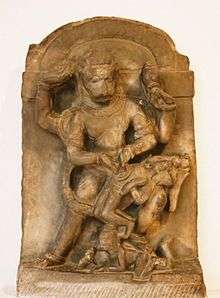
In Andhra Pradesh, a panel dating to third-fourth century AD shows a full theriomorphic squatting lion with two extra human arms behind his shoulders holding Vaiṣṇava emblems. This lion, flanked by five heroes (vīra), often has been identified as an early depiction of Narasiṃha.[39] Standing cult images of Narasiṃha from the early Gupta period, survive from temples at Tigowa and Eran.[40] These sculptures are two-armed, long maned, frontal, wearing only a lower garment, and with no demon-figure of Hiraṇyakaśipu. Images representing the narrative of Narasiṃha slaying the demon Hiraṇyakaśipu survive from slightly later Gupta-period temples: one at Madhia and one from a temple-doorway now set into the Kūrma-maṭha at Nachna, both dated to the late fifth or early sixth century A.D.[41]
An image of Narasiṃha supposedly dating to second-third century AD sculpted at Mathura was acquired by the Philadelphia Museum of Art in 1987. It was described by Stella Kramrisch, the former Philadelphia Museum of Art's Indian curator, as "perhaps the earliest image of Narasiṃha as yet known".[41] This figure depicts a furled brow, fangs, and lolling tongue similar to later images of Narasiṃha, but the idol's robe, simplicity, and stance set it apart. On Narasiṃha's chest under his upper garment appears the suggestion of an amulet, which Stella Kramrisch associated with Visnu's cognizance, the Kauṣtubha jewel. This upper garment flows over both shoulders; but below Hiranyakasipu, the demon-figure placed horizontally across Narasiṃha's body, a twisted waist-band suggests a separate garment covering the legs. The demon's hair streams behind him, cushioning his head against the man-lion's right knee. He wears a simple single strand of beads. His body seems relaxed, even pliant. His face is calm, with a slight suggestion of a smile. His eyes stare adoringly up at the face of Viṣṇu. There is little tension in this figure's legs or feet, even as Narasiṃha gently disembowels him. His innards spill along his right side. As the Matsya purana describes it, Narasiṃha ripped "apart the mighty Daitya chief as a plaiter of straw mats shreds his reeds".[41] Based on the Gandhara-style of robe worn by the idol, Michael Meiste altered the date of the image to fourth century AD.[41]
An image of Narasiṃha, dating to the 9th century, was found on the northern slope of Mount Ijo, at Prambanan, Indonesia.[42] Images of Trivikrama and Varāha avatāras were also found at Prambanan, Indonesia. Viṣṇu and His avatāra images follow iconographic peculiarities characteristic of the art of central Java. This includes physiognomy of central Java, an exaggerated volume of garment, and some elaboration of the jewelry. This decorative scheme once formulated became, with very little modification, an accepted norm for sculptures throughout the Central Javanese period (circa 730–930 A.D.). Despite the iconographic peculiarities, the stylistic antecedents of the Java sculptures can be traced back to Indian carvings as the Chalukya and Pallava images of the 6th–7th centuries AD.[43]
Pilgrimage sites
The following sites in Maharashtra and Uttar Pradesh in India, are associated with Narasiṁha as places of pilgrimage:
- Prahlad Ghat, Hardoi, Uttar Pradesh
- Shri Laxmi Narsimha Temple
See also
- Narasimhasana
- Narsinghji Gufa Temple,Hindaun, Rajasthan
- Shri Laxmi Narsimha Temple
- Löwenmensch figurine
- Narasiṃha Purāṇa
- Narasiṃha Śatkam
- Seebi Narasimha swamy temple
- Ramtek Kevala Narasimha temple inscription
References
- George M. Williams (2008). Handbook of Hindu Mythology. Oxford University Press. p. 223. ISBN 978-0-19-533261-2.
- Gavin D. Flood (1996). An Introduction to Hinduism. Cambridge University Press. p. 111. ISBN 978-0-521-43878-0.
- Roshen Dalal (2010). The Religions of India: A Concise Guide to Nine Major Faiths. Penguin Books. p. 148. ISBN 978-0-14-341517-6.
- Roshen Dalal (2010). The Religions of India: A Concise Guide to Nine Major Faiths. Penguin Books. p. 148. ISBN 978-0-14-341517-6.
- Nanditha Krishna (2009). The Book of Vishnu. Penguin Books. pp. 50–53. ISBN 978-0-14-306762-7.
- Steven J. Rosen, Narasiṁha Avatar, The Half-Man/Half-Lion Incarnation, p5
- Gopal, Madan (1990). K.S. Gautam (ed.). India through the ages. Publication Division, Ministry of Information and Broadcasting, Government of India. p. 734.
- Farley P. Richmond; Darius L. Swann; Phillip B. Zarrilli (1993). Indian Theatre: Traditions of Performance. Motilal Banarsidass. pp. 127 with footnote 1. ISBN 978-81-208-0981-9.
- Soifer, Deborah A. (1991). The Myths of Narasiṁha and Vāmana: Two Avatars in Cosmological Perspective. Albany, N.Y: State University of New York Press. ISBN 0-7914-0799-3.
- Meister, Michael W. (1996). "Man and Man-Lion: The Philadelphia Narasimha". Artibus Asiae. 56 (3/4): 291–301 with footnotes. doi:10.2307/3250120.
- For English summary, see page 80 Schmid, Charlotte (1997). Les Vaikuṇṭha gupta de Mathura : Viṣṇu ou Kṛṣṇa?. pp. 60–88.
- "Eight sacred names of Lord Narsimha to remove the fear". www.speakingtree.in. Retrieved 8 January 2020.
- The Rigveda Mandala 1 Hymn 154, Ralph T.H. Griffith, Wikisource
- Deborah A. Soifer (1991). The Myths of Narasimha and Vamana: Two Avatars in Cosmological Perspective. State University of New York Press. pp. 37–39. ISBN 978-0-7914-0799-8.
- Bloomfield, Maurice (1893). "Contributions to the Interpretation of the Veda". Journal of the American Oriental Society. American Oriental Society. 15: 143–156. doi:10.2307/592353.
- Fowler, Murray (1942). "The Role of Surā in the Myth of Namuci". Journal of the American Oriental Society. American Oriental Society. 62 (1): 36–40. doi:10.2307/594098.
- Walter Ruben (1968), Fighting against despotes in old Indian literature, Annals of the Bhandarkar Oriental Research Institute, Vol. 48/49, Golden Jubilee, Volume 1917-1967 (1968), pp. 111-118
- Steven J. Rosen, Narasiṁha Avatāra, The Half-Man/Half-Lion Incarnation, p1
- Ravi M. Gupta; Kenneth R. Valpey (2013). The Bhagavata Purana: Sacred Text and Living Tradition. Columbia University Press. pp. 21–23, 32–35. ISBN 978-0-231-53147-4.
- David Leeming (2001). A Dictionary of Asian Mythology. Oxford University Press. pp. 125–126. ISBN 978-0-19-512053-0.
- S. M. Srinivasa Chari (1994). Vaiṣṇavism: Its Philosophy, Theology, and Religious Discipline. Motilal Banarsidass. pp. 35–38. ISBN 978-81-208-1098-3.
- Deussen, Paul (1997). Sixty Upanishads of the Veda. Motilal Banarsidass. pp. 809–858. ISBN 978-81-208-1467-7.
- S. M. Srinivasa Chari (1994). Vaiṣṇavism: Its Philosophy, Theology, and Religious Discipline. Motilal Banarsidass. pp. 132–134. ISBN 978-81-208-1098-3.
- "HariHarji". hariharji.blogspot.com. Retrieved 8 January 2020.
- Soifer, p.85: K.P.1.15.70
- Alexandra Anna Enrica van der Geer (2008). Animals in Stone: Indian Mammals Sculptured Through Time. BRILL Academic. pp. 404–407. ISBN 90-04-16819-2.
- Pratapaditya Pal (1986). Indian Sculpture: Circa 500 B.C.-A.D. 700. University of California Press. pp. 42–43. ISBN 978-0-520-05991-7.
- "Shri Panchmukhi Hanuman – The Story Behind The Five Faces of Lord Hanuman". Indian Astrology. 24 October 2016. Retrieved 9 November 2017.
- Vemsani, Lavanya (2009). "Narasimha, The Supreme Deity of Andhra Pradesh: Tradition and Innovation in Hinduism- An Examination of the Temple Myths, Folk Stories, and Popular Culture". Journal of Contemporary Religion. 24 (1): 35–52. doi:10.1080/13537900802630489.
- Daniel E Bassuk (1987). Incarnation in Hinduism and Christianity: The Myth of the God-Man. Palgrave Macmillan. pp. 27–28. ISBN 978-1-349-08642-9.
- Emilia Smagur 92015), Vaishnavite Influences in the Kushan Coinage, Notae Numismaticae. Zapiski numizmatyczne, Issue 10, pages 63-85
- Los Angeles County Museum of Art; Pratapaditya Pal (1986). Indian Sculpture: Circa 500 B.C.-A.D. 700. University of California Press. p. 192. ISBN 978-0-520-05991-7.
- Los Angeles County Museum of Art; Pratapaditya Pal (1986). Indian Sculpture: Circa 500 B.C.-A.D. 700. University of California Press. pp. 252–253. ISBN 978-0-520-05991-7.
- Philip Zarrilly (1984). The Kathakali Complex: Performance & Structure. Abhinav Publications. pp. 160–161, 202–212, xxxvi (Figure 12). ISBN 978-81-7017-187-4.
- Farley P. Richmond; Darius L. Swann; Phillip B. Zarrilli (1993). Indian Theatre: Traditions of Performance. Motilal Banarsidass. pp. 140, 172–173. ISBN 978-81-208-0981-9.
- "Powerful Narasimha Mantras - For Protection - With Meaning, Benefits, Chants". TemplePurohit - Your Spiritual Destination | Bhakti, Shraddha Aur Ashirwad. Retrieved 8 January 2020.
- "Bhakti". Om Narasimhaya Namah. Retrieved 8 January 2020.
- "NARASIMHA - Sri Lakshmi Nrusimha Karavalamba Stotram Learning Aid - Agasthiar.Org". agasthiar.org. Retrieved 8 January 2020.
- Abdul Waheed Khan, An Early Sculpture of Narasiṁha, Andhra Pradesh Government Archaeological Series 16, Hyderabad: Government of Andhra Pradesh, 1964.
- Alexander Cunningham, Archaeological Survey of India, Annual Reports IX (1873-75), p.47
- Michael W. Meiste, Man and Man-Lion: The Philadelphia Narasiṁha, Artibus Asiae, Vol. 56, No. 3/4 (1996), pp. 291–301
- Jan Fontein, et al. (1990). The sculpture of Indonesia, p. 145
- Debjani Paul (1978) Deity or Deified King? Reflections on a Unique Vaiṣṇavite Sculpture from Java', Artibus Asiae, Vol. 40, No. 4 (1978), pp. 311–333.
External links
| Wikimedia Commons has media related to Narasimha. |
- Iconography and Symbolism of Pañcamukha Narasimha, R. Kalidos (1987)
%2C_Gupta_period%2C_mid-5th_century_AD._Boston_Museum.jpg)
